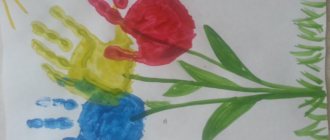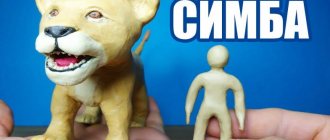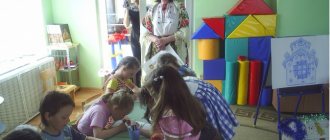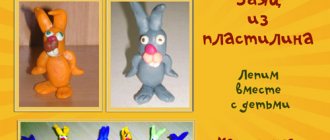Tasks:
"Cognitive development":
- consolidate and generalize the signs of early spring; revive ideas about the first spring flowers.
— to cultivate in children a love of nature, to develop an interest in learning about nature;
“Artistic and ethical development”:
- practice cutting a circle from a square, rounding the corners; cut the circle in half to create a semicircle.
— develop skills in working with paper, making neat, precise folds;
- develop imagination and creativity in children.
“Speech development”:
expand children's vocabulary on the topic: “Flowers”,
develop children's coherent speech
Materials: scissors, glue, brushes, napkins, blue and green colored squares
Primrose and crocus – spring rebirth
Its name is translated from Latin - “first”. Primrose blooms in all the colors of the rainbow. People call it rams or golden keys. They say that these “keys” open the door to summer.
There is also a superstition that primrose can open hidden treasures. A maiden dressed in white robes and holding a golden key in her hand sometimes appears in the fields. And if you pick a primrose with her, the flower receives a magical gift of finding underground and opening treasures.
Simultaneously with the primrose, and sometimes even before it, the lovely crocuses open their blue eyes.
Summary of a lesson on application in the senior group. Bouquet of flowers
Summary of a lesson on appliqué in the senior group on the topic “Bouquet of Flowers.”
Author: Tatyana Ivanovna Ionova, teacher of the preschool educational institution “Kindergarten No. 24”, the city of Cheremkhovo, Irkutsk region. Description of the material: I offer you a summary of directly organized educational activities in a group room for children of the older group (5-6 years old). This material will be useful to educators of the older group. Objectives of the priority educational area: cognitive development - the formation of primary ideas about objects in the surrounding world and their properties (color, size, shape). Objectives of the educational field in integration: artistic and aesthetic development - introducing children to visual arts (drawing up a composition using an unconventional technique for making work from pasta). Development of a sense of rhythm and composition. Education of artistic taste. Prerequisites for educational activity: cognitive component - highlights the essential features of specifically sensory objects. Equipment for the teacher : telegram, bag of pasta of different shapes (spirals, feathers, leaves, shells, bows and others), containers; multimedia (screen, laptop, projector) - video panorama “At the Pasta Factory”, musical audio recording “I will make friends with sports” (author: A. I. Piletskaya, music: D. Trubachev, V. Trubacheva), artificial path, basket , dummies - products (potatoes, mushrooms, milk, egg, glass/bottle of water, flour, salt). Equipment for children : colored socks (“running boots”), magic glasses (made of cardboard), white cardboard A-4 format, pasta of various shapes (spirals, feathers, leaves, shells, bows and others), peas (round and crushed ), PVA glue, brushes (wide and thin), paper and cloth napkins, a jar of water, a simple pencil, an eraser; watercolor and acrylic paints, gouache. Preliminary work: reading “A Series of Tales about the Adventures of Cook Granmulino” (author: Anton Robin), looking at illustrations with bouquets of flowers, vases of different shapes;
memorizing the verse “Lunch with pasta.” Progress of the lesson:
Knock on the door. The postman Pechkin enters. Postman Pechkin: Hello, guys! This morning, you received a telegram. Here I brought it. And the cook Granmulino sent it. What do you think is written in this telegram (children’s reasoning)
.
Guys, can you read? Will you read it yourself? (children's answers)
.
Let me help you read it. Postman Pechkin reads a telegram : “Kindergarten No. 24. Magic workshop of the senior group “Bees.” Hello guys! I am the chief cook of the country of Macaronia, the noble Granmulino. A competition has been announced for the residents of our country of Macaronia - a craft project “Bouquet of Flowers”, in which I want to participate. But, unfortunately, flowers don’t grow in my garden. But I have a lot of pasta and I heard that you can make various crafts from it. Maybe you can help me make a pasta craft to send to the competition?! I urgently need your help. I invite you to the country of Macaronia!” Postman Pechkin : Guys, have any of you been to the country of Macaronia? Maybe your parents told you about this country? Why do you think this country is called so - Macaronia? What can they produce in this country and who works there? (children's answers
). Do you like to travel? Let's leave our magical workshop and go to visit the chef Granmulino in the country of Macaronia... Well, in order to go on a trip, we need magic.
Game "Find and name."
Find in the pictures and name fairy tales in which magic or magical objects helped fairy-tale characters go on a journey
(children’s answers)
(fairy tales: “The Little Humpbacked Horse”, “The Magic Ring”, “Ivan Tsarevich, the Gray Wolf and Elena the Beautiful”, “ Firebird", "Rejuvenating Apples" etc. Magic items - an invisibility hat, running boots, an airplane carpet, a self-assembled tablecloth and others).
Postman Pechkin: Guys, cook Granmulino urgently needs help, I suggest you put on magic boots and go on a journey. Let’s all say the magic words together: “One, two, three... quickly run to the land of Macaronia! " (the music “I’ll make friends with sports” plays. Children put on “walking boots” and imitate movements while completing a task along an artificial path). The noble cook Granmulino enters. Chef Granmulino: Hello, guys! Here you are in the country of Macaronia! My assistants! Thank you for responding to my request and deciding to help me! (children sit on chairs).
Guys, before you help me make a craft, I suggest you take a tour of the pasta factory.
Do you know how pasta is made? (children's answers)
. I invite you to take part in making pasta. To begin with, you need to select the products that are needed to make pasta. We'll put the products in a magic basket and take them with us to the pasta factory.
Game “Guess it” (riddles on the topic “Products”).
1. I will always find this delicious food in the forest.
Grandma and I will fry them, salt them, and boil them. (Mushrooms). 2. There’s wheat at the mill. This is what’s happening to it! They will take it into circulation and grind it into powder! (Flour) 3. It can break, It can cook, If you want, It can turn into a bird. (egg) 4. Grandma will take out a jar of buckwheat, rice or semolina. Then grandma will boil the cereal in a saucepan with milk. Eat, eat in the morning, children, the best food in the world! (Porridge) 5. No cooking, no washing, Without what, let’s say frankly, Should a person die? So that rain pours from the sky, So that ears of bread grow, So that ships sail - We cannot live without... (Water) 6. Separately, I am not so tasty, But as food, everyone needs it. (salt) 7. Unprepossessing, a little small, Only all the guys love it Baked in the fire, In a fragrant peel. “Russian bread”, We call the baby - Our good one... (Potatoes) 8. White, but not snow, Delicious, but not honey. They take it from the horned one and give it to the guys. (Milk) Children select and put in a basket only those products (guess) that relate to the production of pasta. Name the properties of these products. Chef Granmulino: Well done! The magic basket is filled with products. Guys, what do you think is used to knead pasta dough? Who is doing this? (children's answers).
I suggest you go on an excursion to a pasta making workshop. Wear magic glasses! Be careful! (Children put on glasses. View a multimedia video panorama on the topic:
virtual tour “At the pasta factory”).
Chef Granmulino: Guys, did you enjoy the tour of the pasta factory? How is pasta made? What are the names of the machines that help a person make pasta? (children's answers).
Chef Granmulino shows a bag with different types of pasta:
Chef Granmulino : Guys, the workers at the pasta factory made a lot of pasta, but they all got mixed up.
Let's help the workers and find pasta that is the same color and shape and put them in containers. Game "Lay it out correctly."
Children put pasta into containers.
Chef Granmulino: What does pasta taste like? They are identical? How are they different from each other? Let's try pasta. Do you think they can be eaten raw? Tasty? Is this product edible? What qualities does pasta have? Can you name it? (hard, durable, yellow or white, different shapes and sizes. Place them in the palm of your hand, is it hard or easy to hold the pasta?) Children try (give their opinion)
.
Chef Granmulino: Guys, pasta can not only be eaten, but it can be used in the production of creative works. How do you think you can make a craft out of pasta? (children's answers). Chef Granmulino: Maybe, children, do you know some verse about pasta?
The child reads a poem. Reading a poem. "Lunch with pasta."
Pasta was pretend to be called “makaroshki”.
Pasta rolls rolled along the path. A large army gathered to collect pasta: Mouse, Cat, dog Timoshka, fly Nyushka, Beetle Chernushka and some kind of frog. Yes, but the Mouse, yes, but the Cat, Yes, but stupid Timoshka, the fly Nyushka and Chernushka (Just like someone else’s frog) They don’t need pasta, pasta is funny to them. And to taste, and to hear, and to touch, and to smell! The cat only loves lard. The mouse eats quite a bit. Timoshka the dog loves soup. Mushkin's taste is quite rough. In the morning, afternoon and evening, the Chernushka beetle eats bark. “Well, what,” asked Mushka, “What does a frog eat?” And the frog answered her: “Come for lunch!” And she went to her swamp, closing the gate behind her. Chef Granmulino: Well done, guys! Well, you know everything! Did you enjoy the excursion to the pasta factory? In my country there is nothing else except pasta. What should we do, what should we do? (answers, suggestions from children).
The children invite chef Granmulino to visit them - a magical workshop where they make their crafts.
Chef Granmulino agrees. Chef Granmulino: But how will we end up in your magical workshop? Children: We must say the magic words! Repeat after us: “One, two, three... quickly run from the country of Macaronia boots to the workshop!” (the music “I’ll make friends with sports” plays. Children put on running boots and imitate movements while completing tasks along the path). Chef Granmulino: Thank you, guys, for not leaving me in trouble! Now listen and remember how to prepare a “Bouquet of Flowers” craft for the competition: 1. Take templates of a vase and flowers (4-5 pieces to choose from), trace them with a pencil on cardboard. 2.On the outlined figure, carefully spread the glue with a brush, without going beyond the contours. 3.Take pasta (optional) and, pressing firmly, glue them without disturbing the desired markings of the outlined figure. 4.Continue to work on gluing the pasta onto the other circled shapes one by one. 5. Draw children’s attention to the location of the applique on the background and the strength of the material’s attachment with glue. 6.After gluing and drying the pasta, take (gouache, watercolor/acrylic paints) and decorate the shapes: vases and flowers. Explain to children that paints can be mixed with each other and made different shades. Chef Granmulino: Let's play with our fingers before we make the craft.
Finger gymnastics: “Kneading the dough”:
We kneaded the dough, we kneaded the dough, We were asked to knead everything thoroughly, But no matter how much we knead and no matter how much we knead, we get lumps again and again.
Chef Granmulino: Well done, you will succeed! And I will help you... (Work done by children).
Children look at their work. They give chef Granmulino their crafts “Bouquet of Flowers”. The noble chef Granmulino thanks the children.
Application
We recommend watching:
Summary of educational activities for children with parents in the middle group. Do-it-yourself doll Summary of a lesson on speech development on the topic “Toys” in the middle group Methodological development of GCD for the development of communicative activities in children of the middle group Synopsis of a game lesson in mathematics in the middle group of a preschool educational institution
Similar articles:
Lesson in the middle group “Winter clothes”
Math lesson notes “Number 1”. Middle group
Volume applique for children. Butterfly
Palm applique. Sun
Floral panel made of corrugated paper
Corrugated paper is a bright, colorful material. The works from it turn out very beautiful, light, airy!
To make a flower panel yourself, you need to prepare in advance:
- Disposable cardboard plate
- Brush
- Gouache
- Stapler
- Glue
- Scissors
- Corrugated paper
Technique for creating panels:
- First prepare the base for the flower panel. Take gouache and tint the plate with it:
- Then form circles and leaves from corrugated paper:
- For each flower, staple 7 petals. And then carefully assemble the petals to class=”aligncenter” width=”675″ height=”480″[/img]
- Glue flowers and leaves to the plate:
If desired, preschoolers can additionally decorate the panel with a paper bird, dragonfly or ladybug!
Volumetric floral applique of daisies
Many children like delicate field daisies. These flowers remind kids of little suns “burning brightly” in the meadow and therefore they are happy to decorate their crafts with daisies. For an applique with sunny daisies in a vase you will need:
- Scissors
- "PVA"
- Pencil
- Ruler
- White paper
- Colored cardboard
Scheme for creating daisies in a vase:
- First, cut the paper sheets into strips 8 cm long and 0.5 cm wide.
- Form circles from yellow cardboard. The diameter of each circle should be 2 cm.
- Now fold the white stripes into a loop and glue them to the back side of the yellow blank, as shown in the photo:
- Form a semicircle from red cardboard. This blank will replace a vase for daisies. The shape of the vase can be any, the main thing is that it is easy for children to glue it.
- Make flower stems from green colored paper.
- Take a sheet of blue cardboard and place all the blanks on it so that you get a beautiful spring applique:










